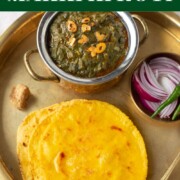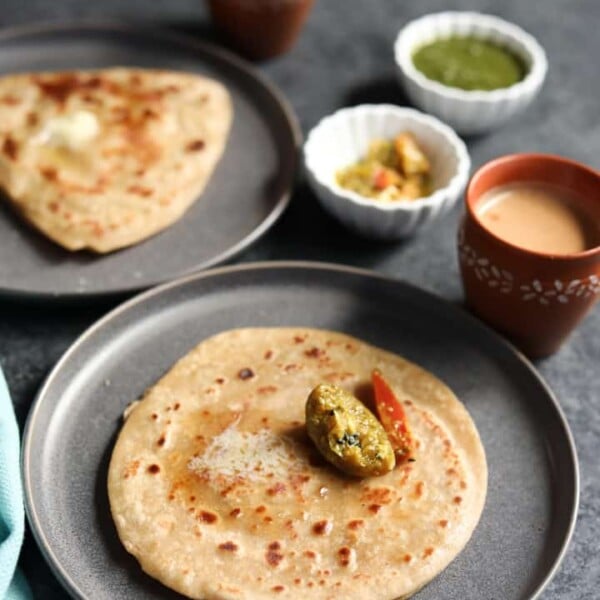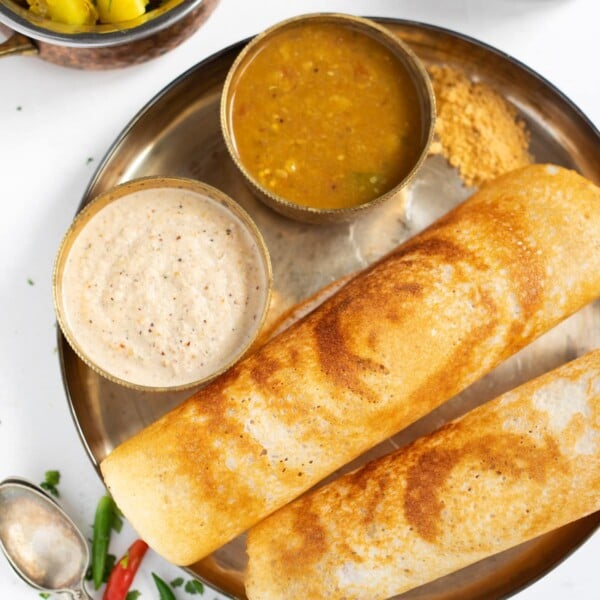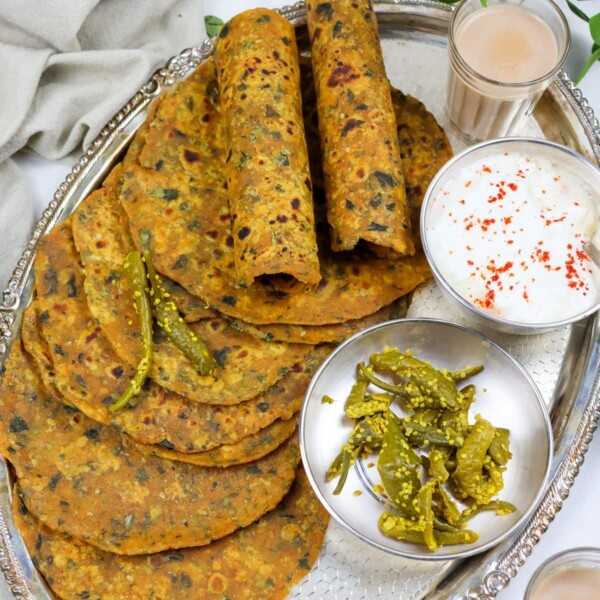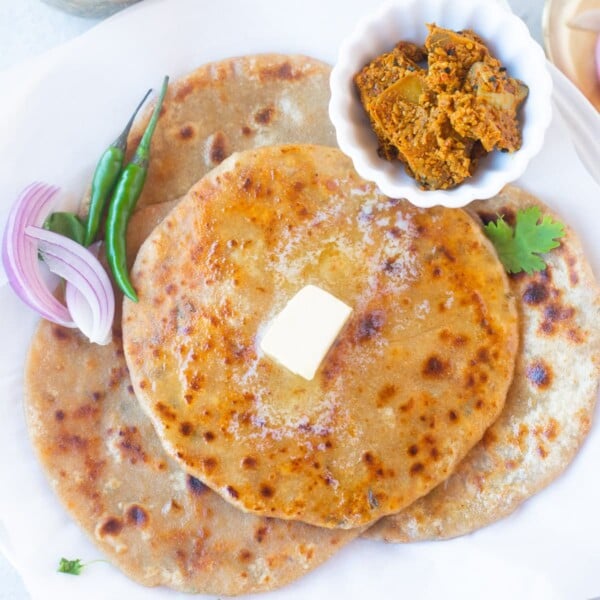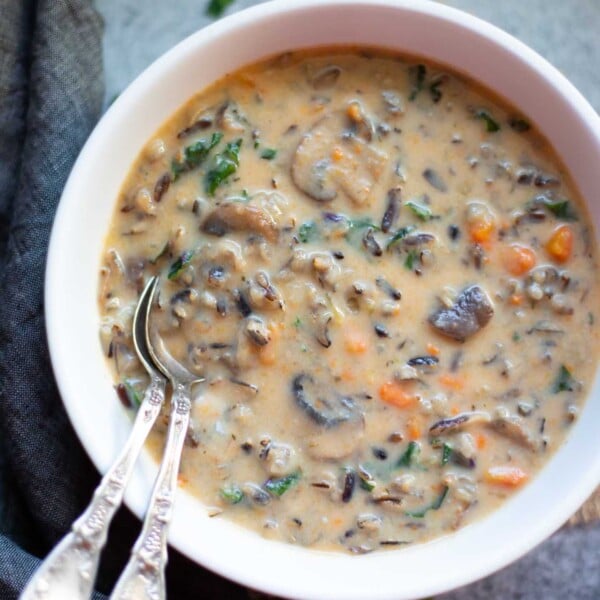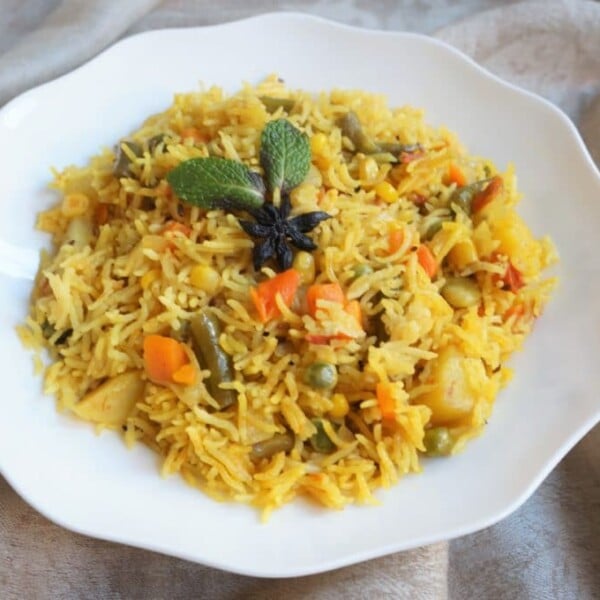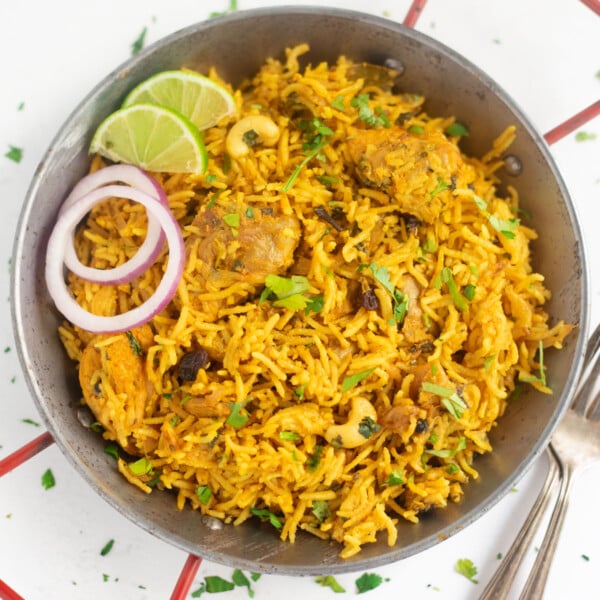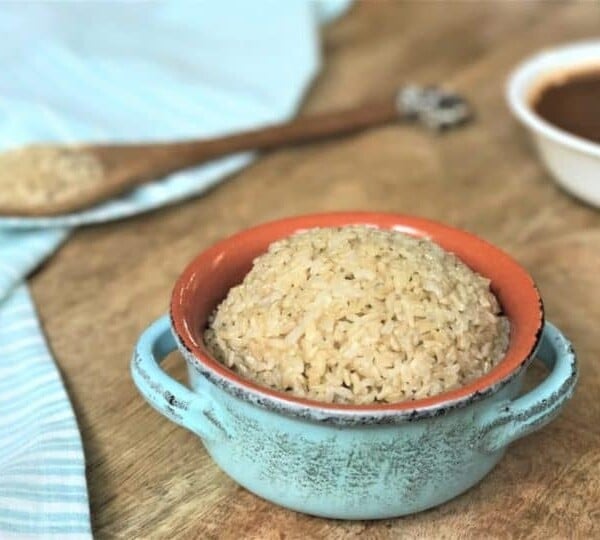Makki ki Roti is a gluten-free flatbread made with yellow cornmeal or maize flour. It is popularly served in North India, along with Sarson ka Saag (mustard greens curry). Learn how to make makki ki roti along with all the tips and tricks with this easy recipe.
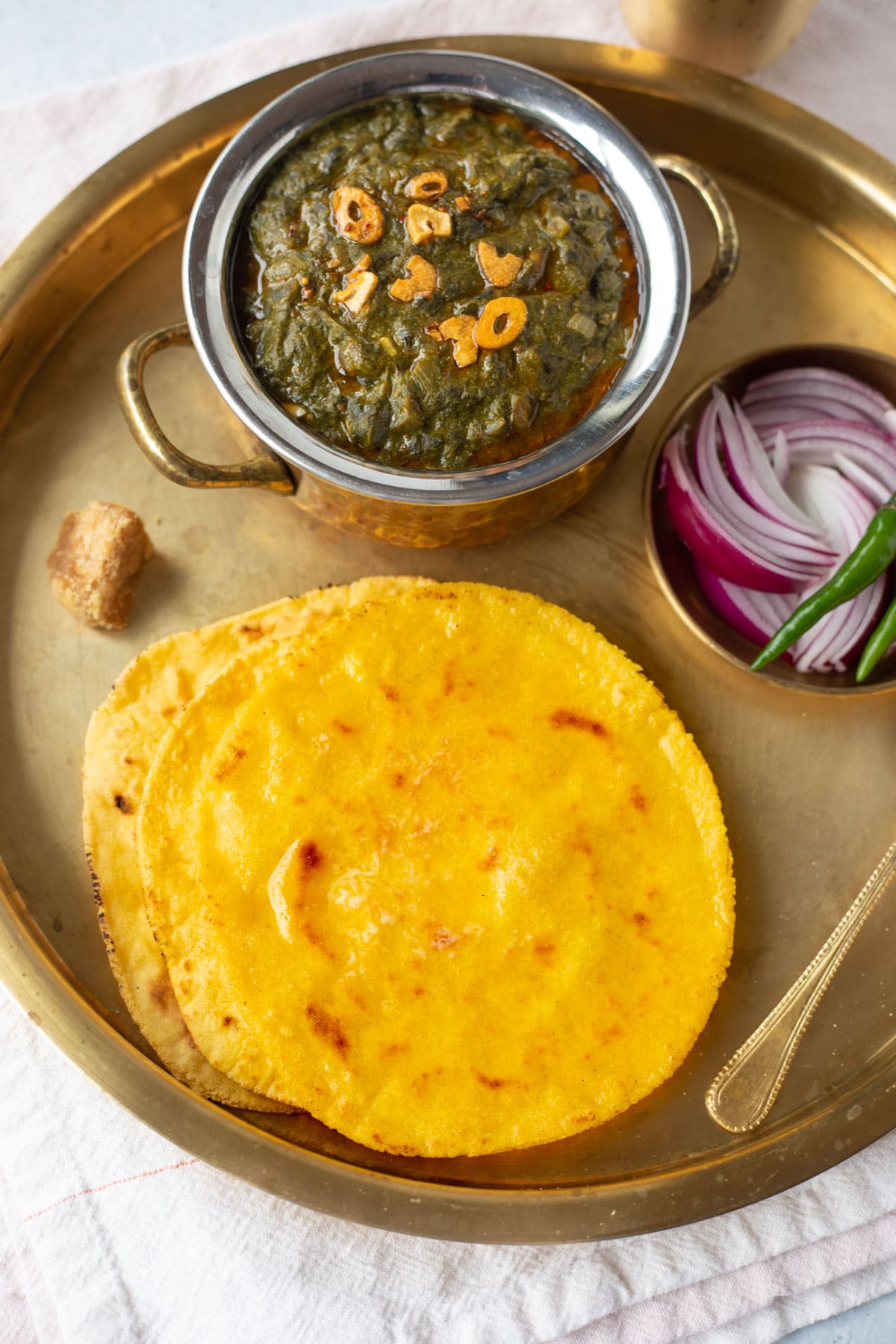
Makki ki roti with sarson ka saag, kadhi pakora, or even palak paneer has been a favorite since childhood times. Mom would make this often during winter when the mustard greens (sarson) are in season.
Top makki ki roti with a dollop of white makhan (butter) and scoop saag with it. It is the BEST MEAL EVER…the ultimate comfort food for a Punjabi!
I always thought that Makki ki roti must be hard to make as it is a gluten-free flatbread. But I have proved myself wrong. If you are new to making this roti, this recipe is for you, my friend.
The recipe is a little different than the traditional method, which is what makes it easier. My mom makes makki ki roti with her hands without using a rolling pin. However, this can be hard if you are a newbie. So I have included the method to make makki ki roti with a rolling pin and with the traditional method.
Give this easy recipe a try, and tell me how you enjoyed it!
Check out more popular Punjabi recipes – Aloo Gobi, Baingan Bharta, Dal Makhani, Punjabi Chole, and Rajma Masala.
Table of Contents
- Watch How to Makki ki Roti
- What is Makki ki Roti?
- Ingredients
- How to make Makki ki Roti?
- Pro-Tips for Perfect Makki ki Roti
- Variations
- What to Serve with Makki ki Roti?
- How to Store Makki ki Roti?
- Can I make Makki ki roti in advance?
- More Indian Flatbread Recipes
- Makki ki Roti (Punjabi Cornmeal Flatbread) Recipe
Watch How to Makki ki Roti
What is Makki ki Roti?
Makki ki Roti, also called Makki di roti in Punjabi, is a flatbread made with maize flour (makki ka aata). “Makki” means Maize and “Roti” means unleavened flatbread.
As maize flour is gluten-free, makki ki roti is a gluten-free bread. Maize flour is also basically fine ground yellow cornmeal. Don’t confuse it with cornstarch.
Typically, this roti is made on a tawa (flat pan) at home. But in restaurants, it might be cooked in a tandoor (clay oven).
In the Punjab region of Northern India, Makki ki Roti is traditionally served with sarson ka saag (spiced leafy greens curry) in the Punjab region. It is also popular in the western region of Rajasthan, where it is served with gatte ki subzi or panchmel dal.
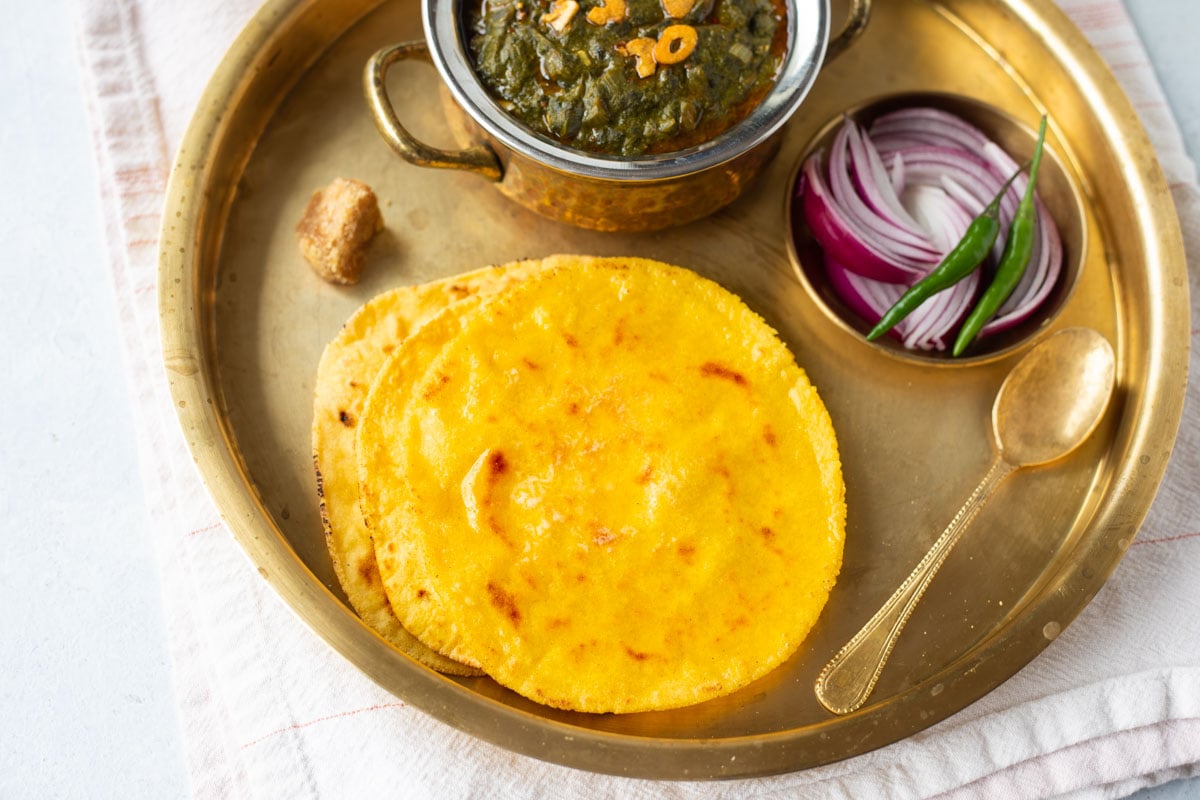
Ingredients
- Maize Flour (Yellow Cornmeal): This is the star ingredient of this flatbread. It is best to use finely ground fresh flour to make this roti. Do not confuse this corn meal with cornstarch, which is typically white in color.
- Salt: Enhances the taste and flavor of the flatbread.
- Ajwain (Carrom seeds): Adds flavor and helps in digestion. Adding ajwain is optional.
- Hot Water: Used for making the dough. Use hot water to make this dough.
- Ghee, Butter, or Oil: Used for roasting the roti and topping on cooked roti.
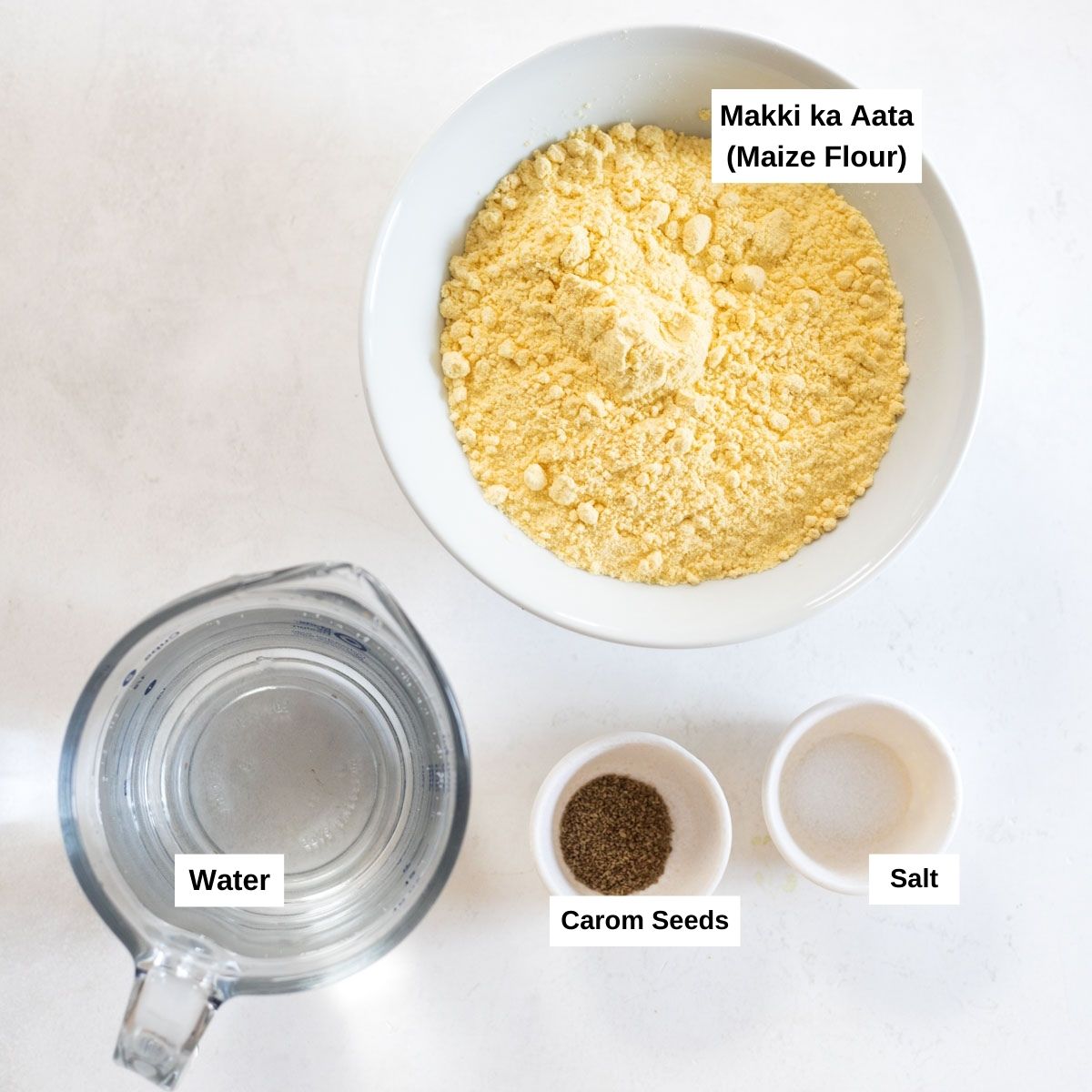
How to make Makki ki Roti?
Making dough
- In a saucepan, add water and salt. Turn the flame to high and let it come to a boil.
- Turn off the flame, and add the makki ka aata and ajwain, if using, to the water. Mix the flour and water with a spatula. It will have a crumbly texture but will start to come together. Cover with a lid and let it rest for 10 minutes.
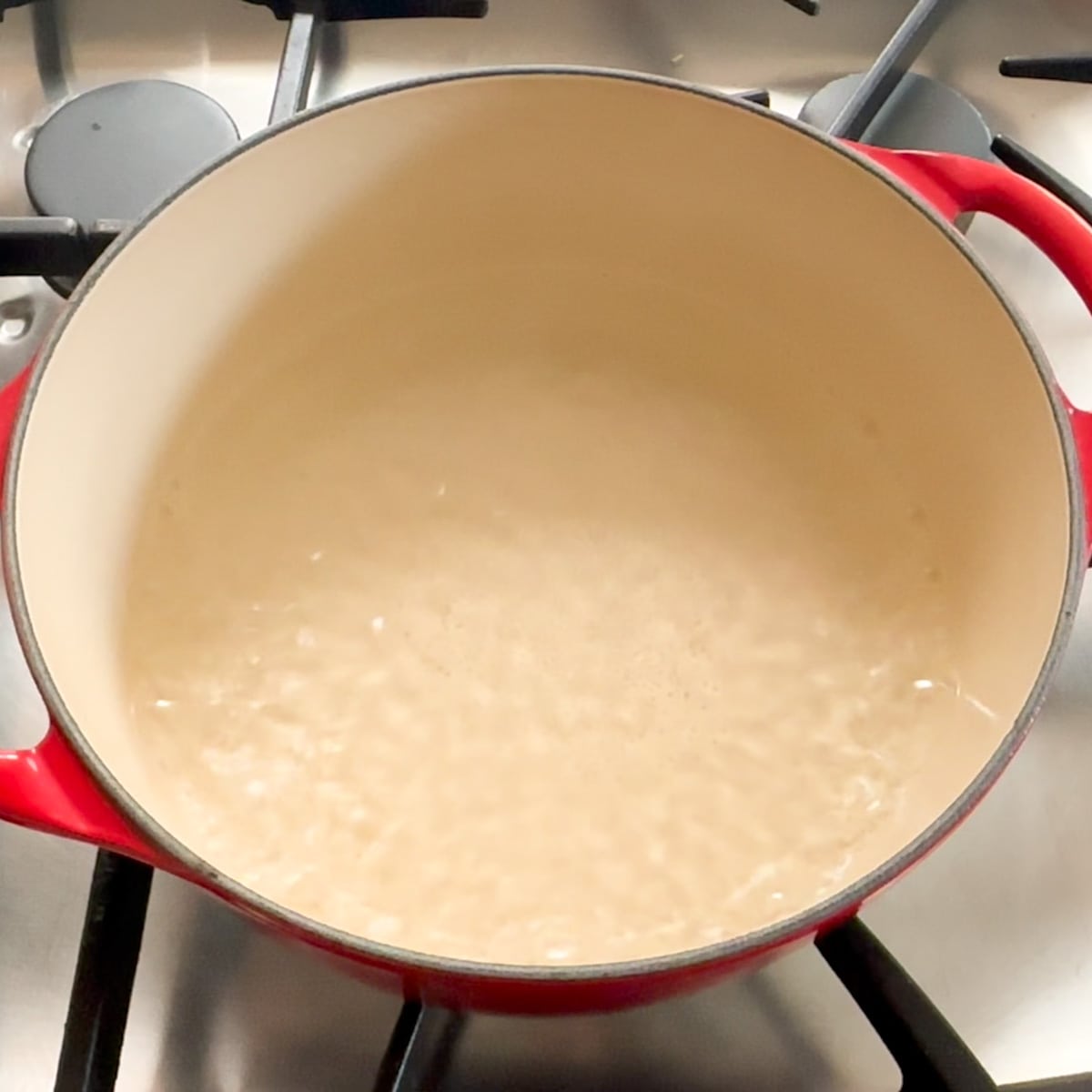
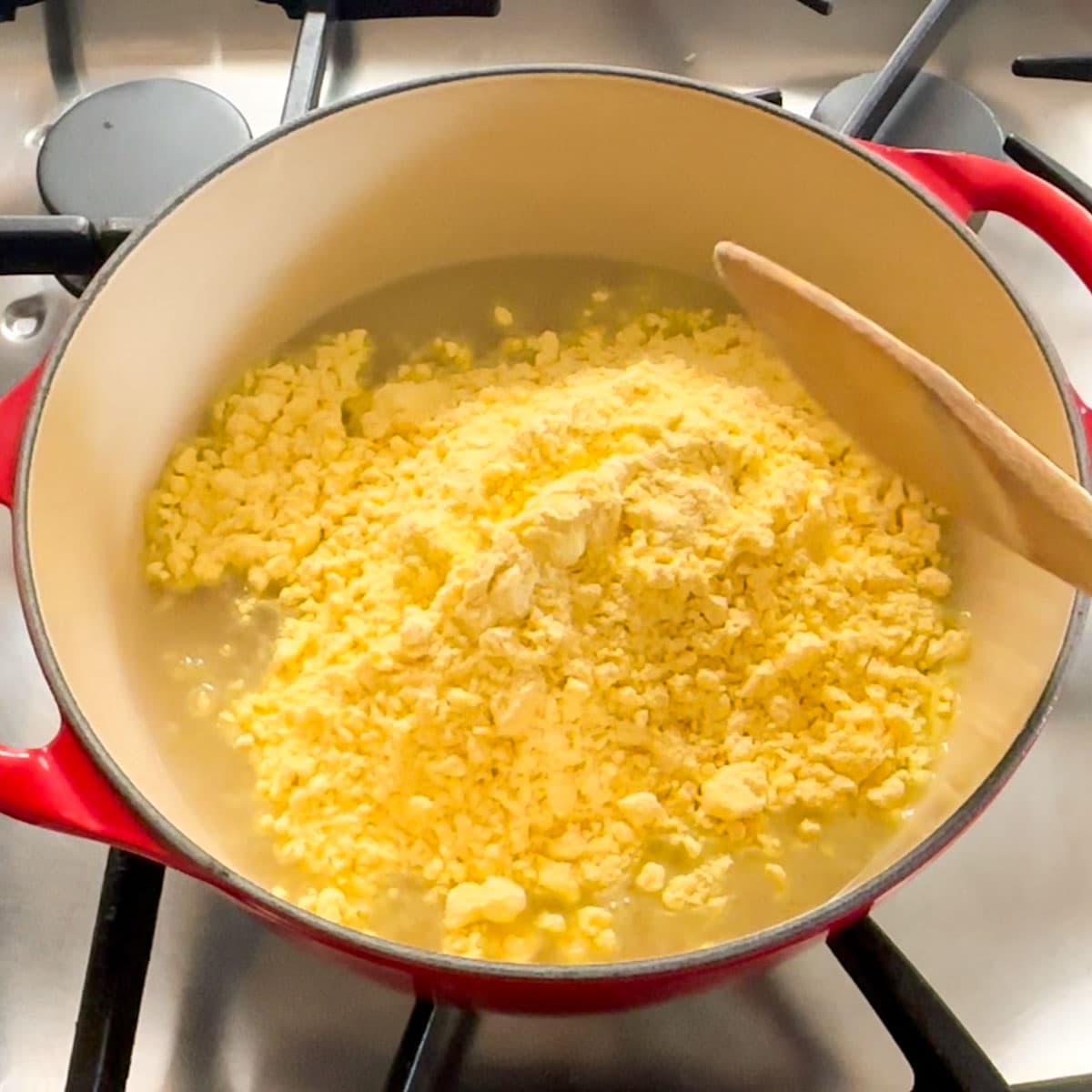
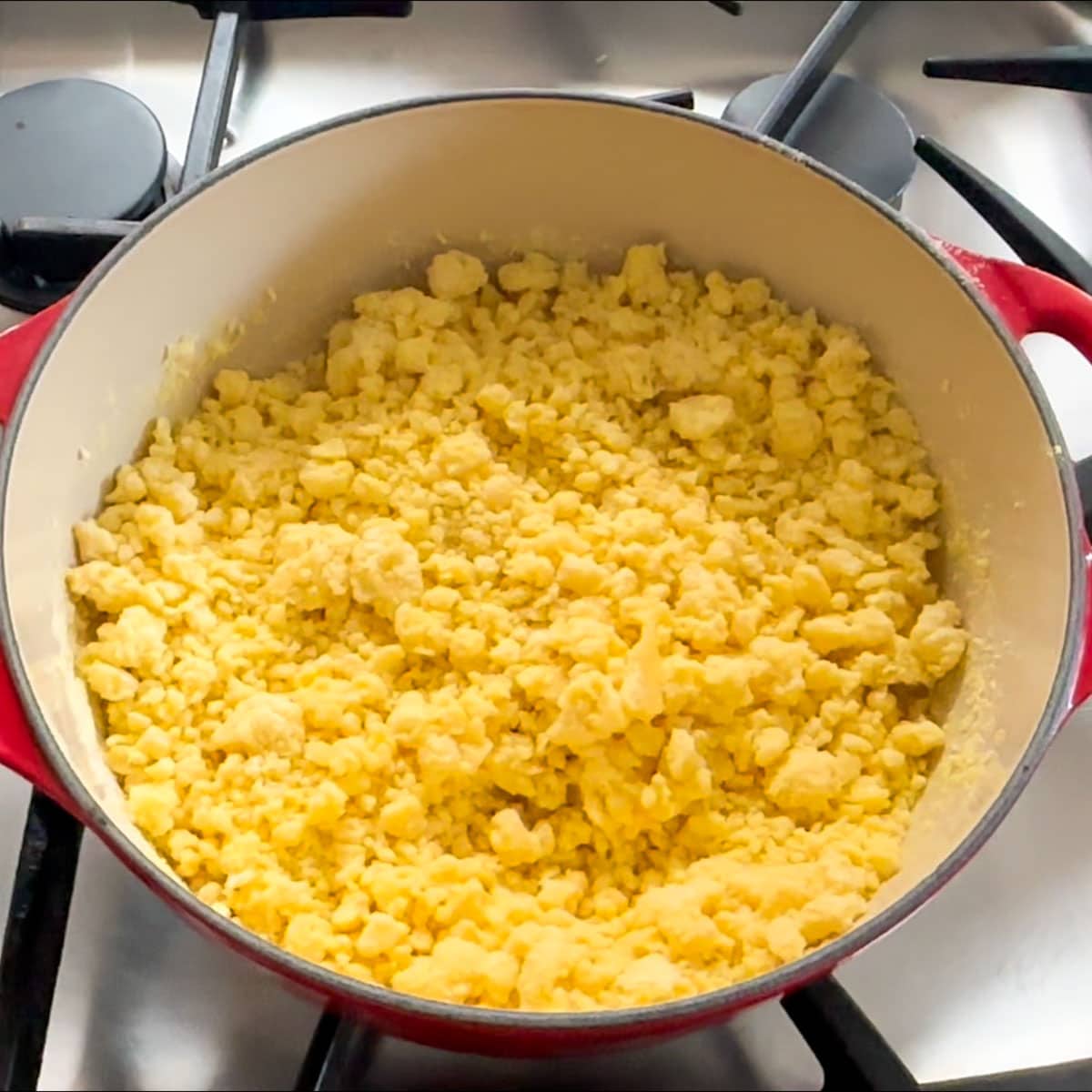
- Open the lid and transfer the mixture to a large plate or bowl. Apply hot water to your hands, and start to knead the dough. Use the heel of your palms to knead it. Keep kneading for 6-8 minutes until the dough is completely smooth.
- If the dough seems dry, add 1-2 tablespoons of hot water and knead again. The dough will be very soft by this time, and you should be able to form a ball without any cracks. Cover the dough with a wet cloth.
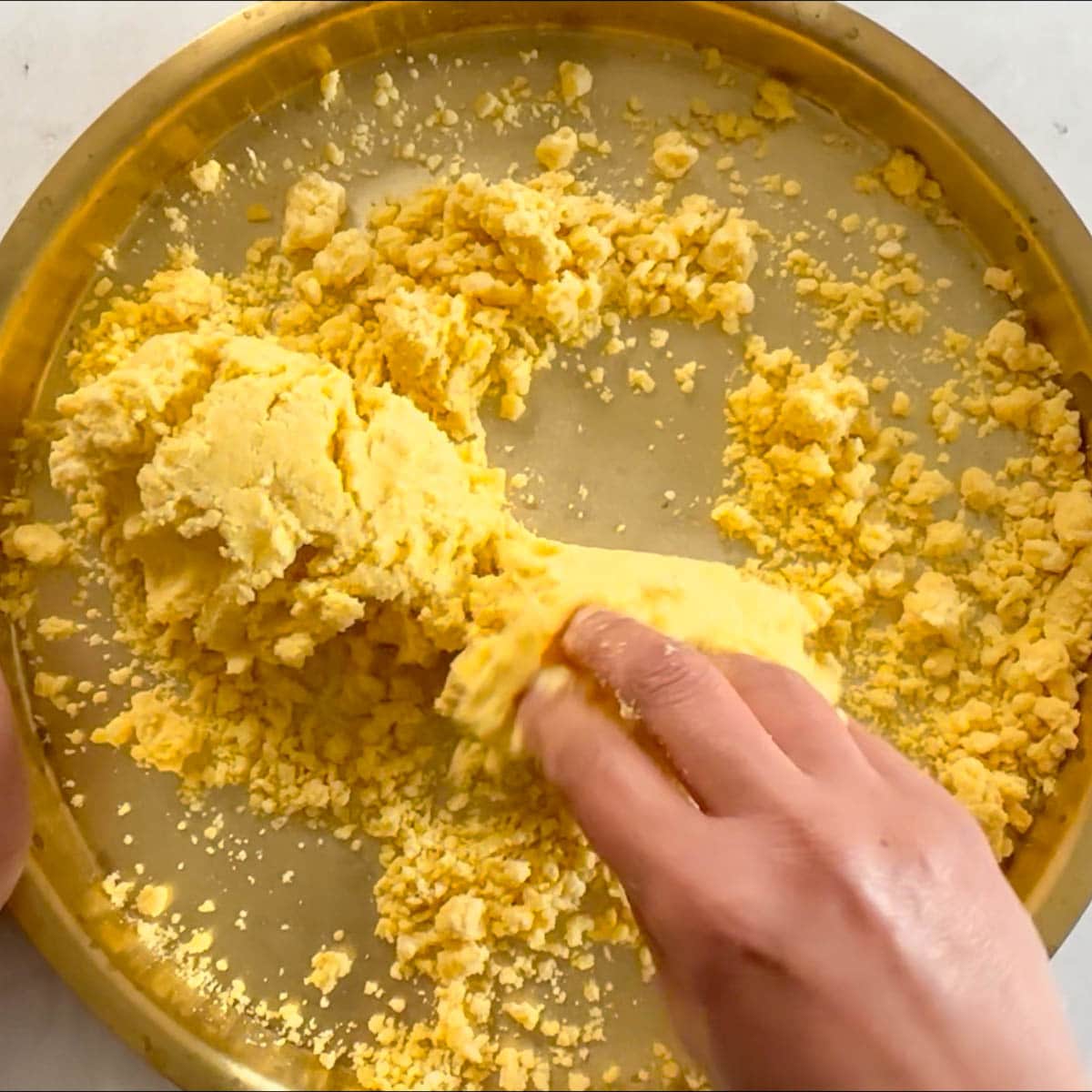
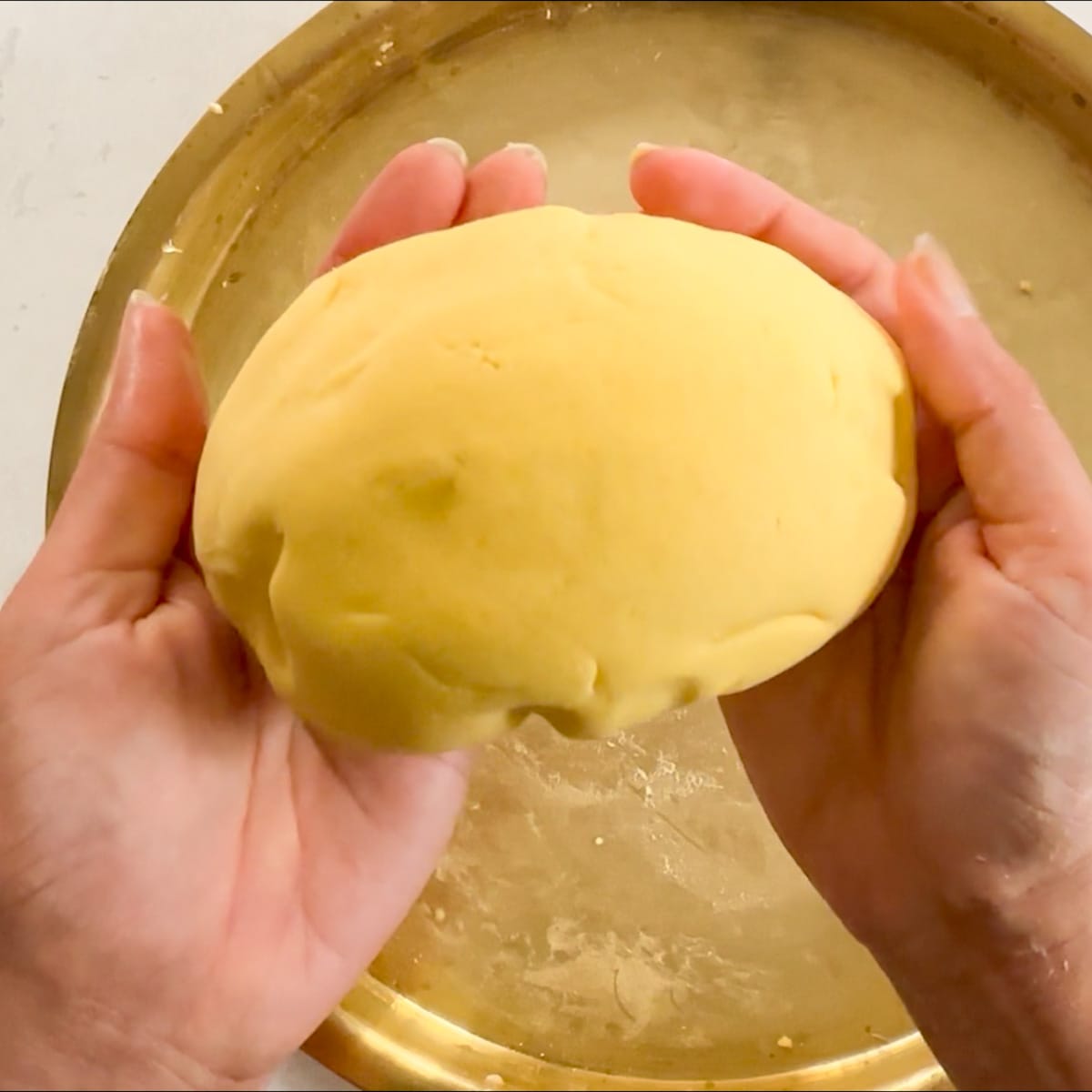
Note: Depending on the quality and age of the flour, the total amount of water needed to make the dough can vary.
Roll the Roti
- Take a small portion of the dough to form a ball. We want to work with one ball at a time. Knead the dough ball one more time until it is smooth. Apply hot water to your hands. If the dough ball seems dry, then knead and make a ball again between your palms.
- Easy method: Apply some dry maize flour to the rolling board. Roll the ball in the maize flour and place it on the rolling board. Using a rolling pin, roll the roti with light hands into a 6-7 inch circle. You can also place the ball on a parchment paper to roll. This helps to make picking the rolled roti easier for the next step.
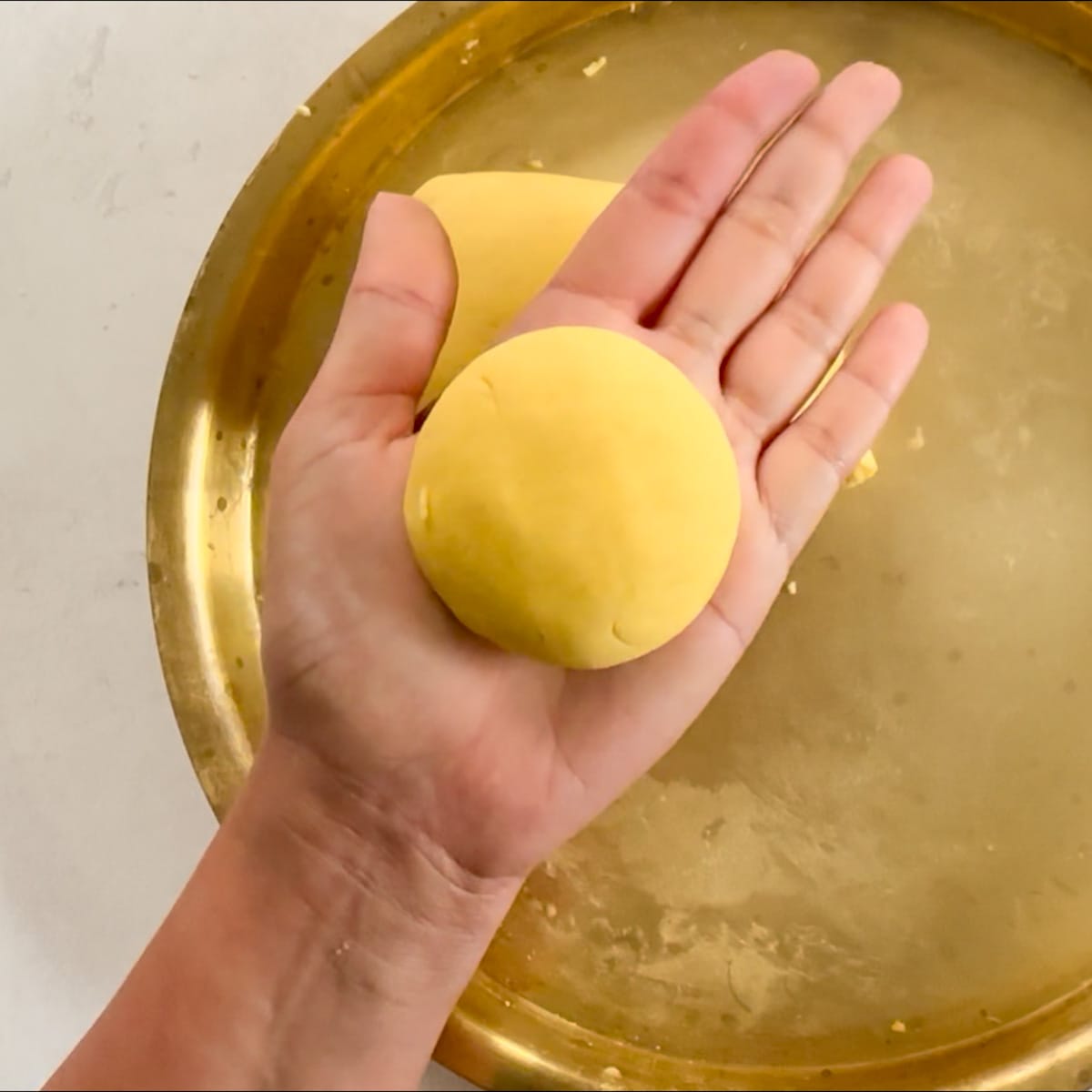
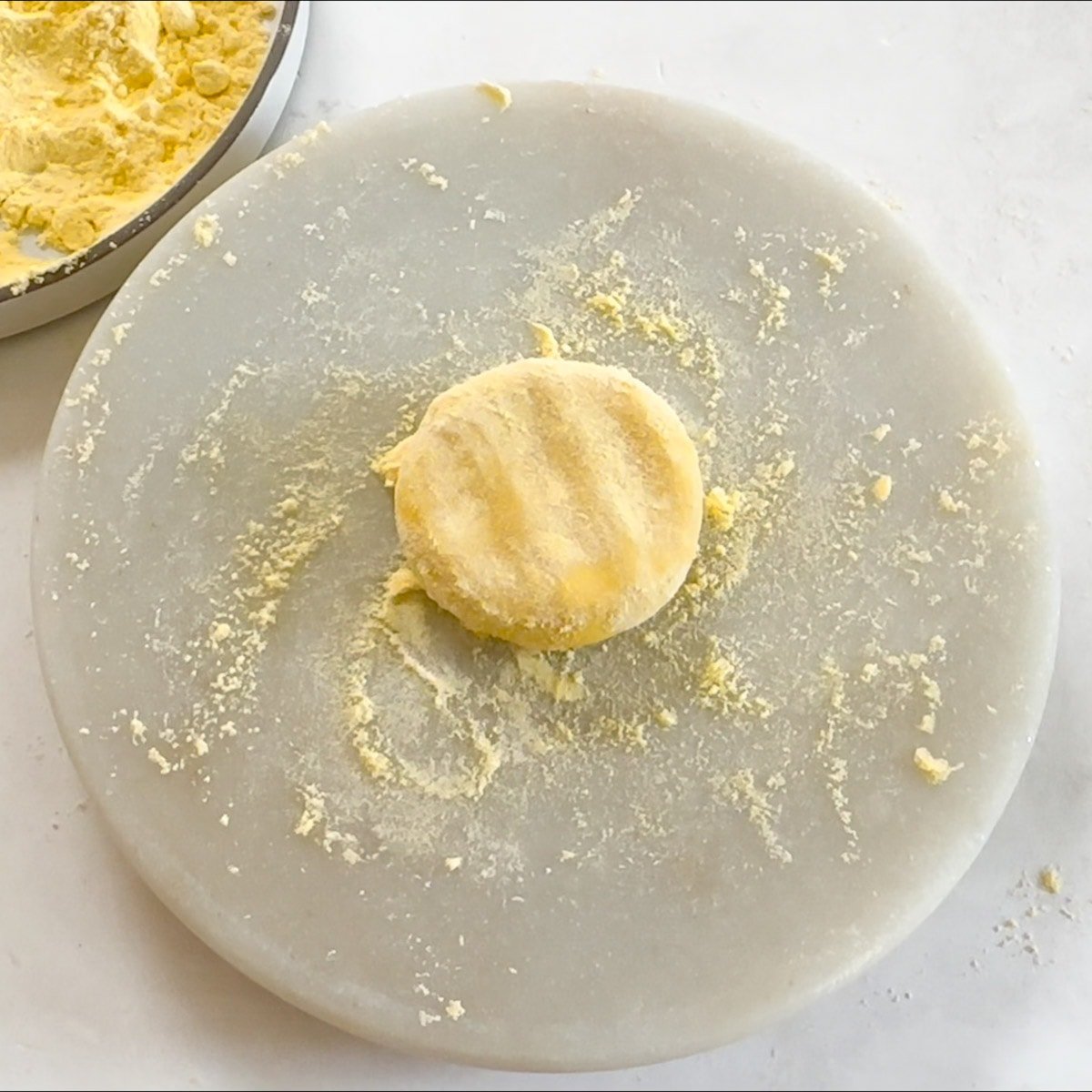
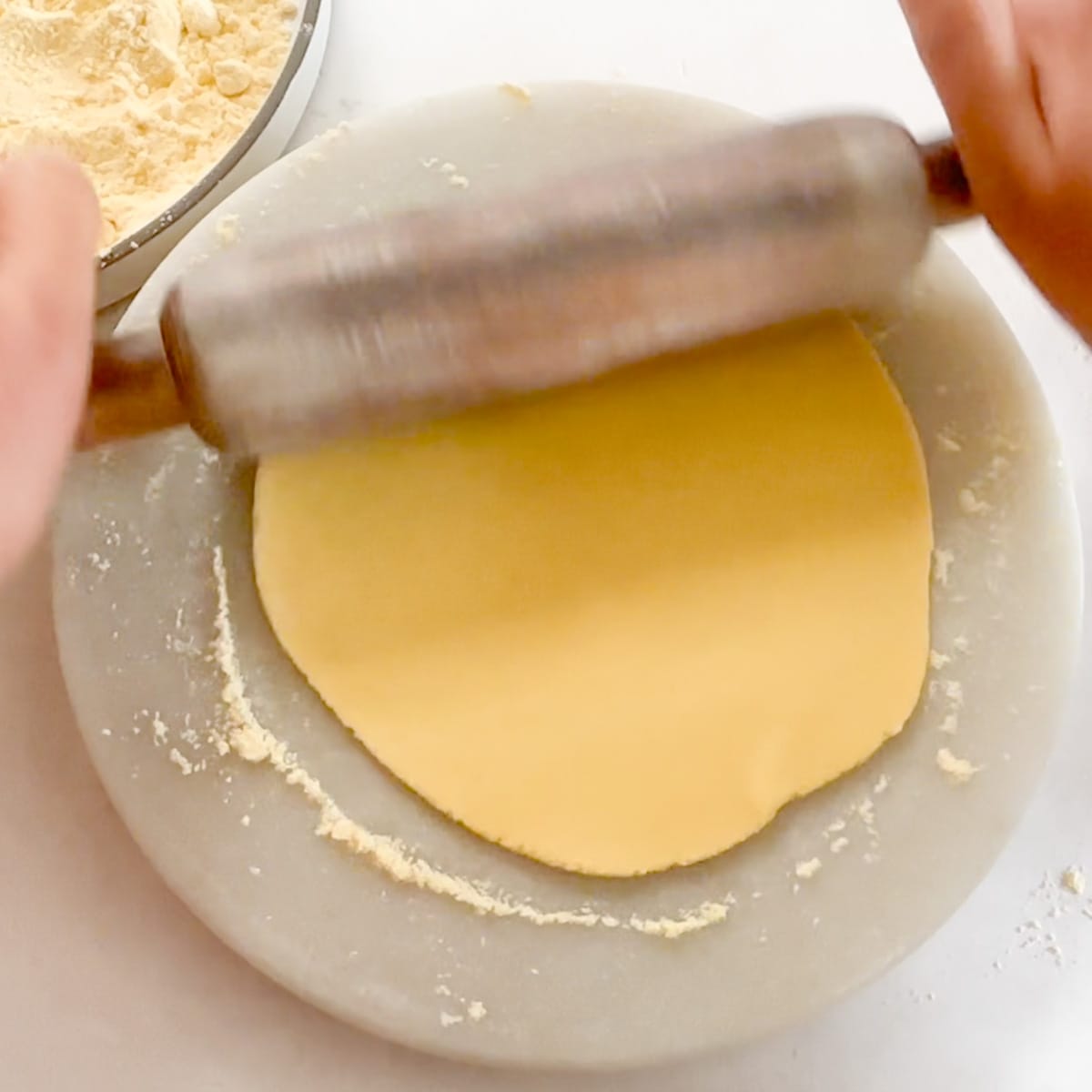
- Traditional method: Wet your hands with hot water. Take the dough ball in your hands and roll the dough between your hands in a circular motion to make a flat circle about double the size of the dough ball. Transfer this onto a parchment paper. Wet your fingers again and start patting the dough while moving the paper to roll evenly on all sides and making a circle. Don’t roll too thin, as usually makki ki roti is thicker than wheat roti’s. If you are new to trying this method, you can make smaller 4-5 inch roti too.
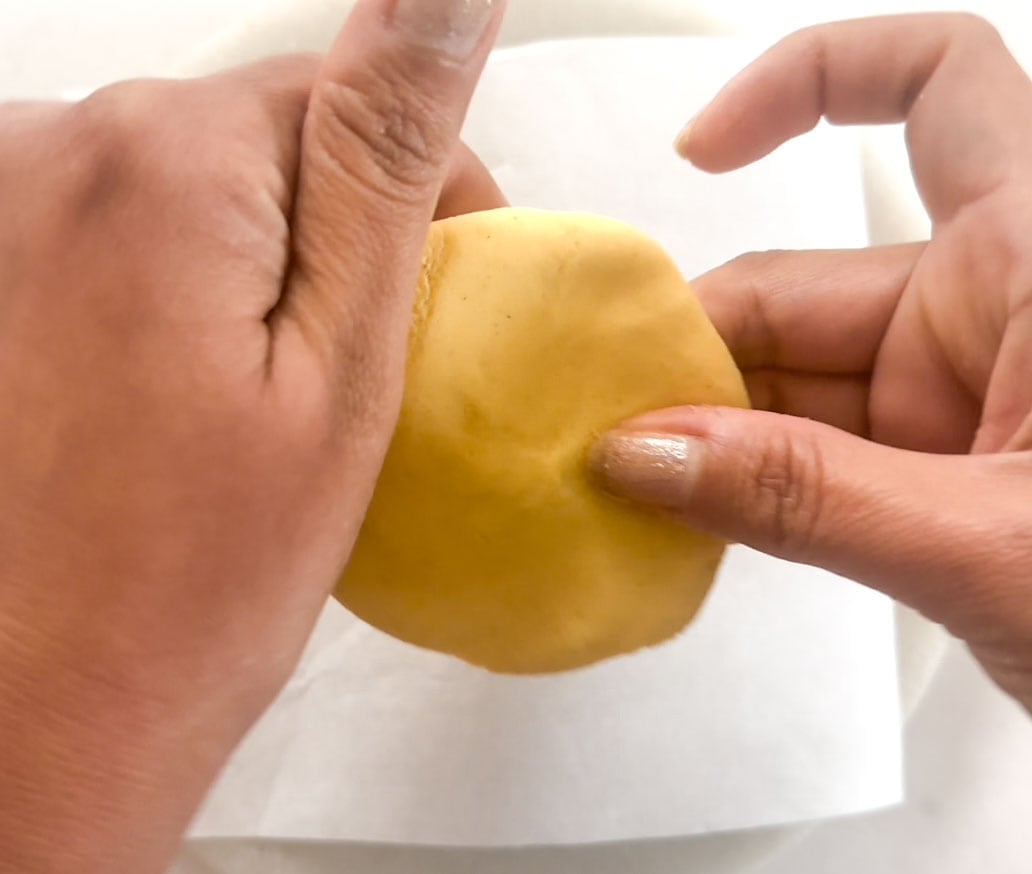
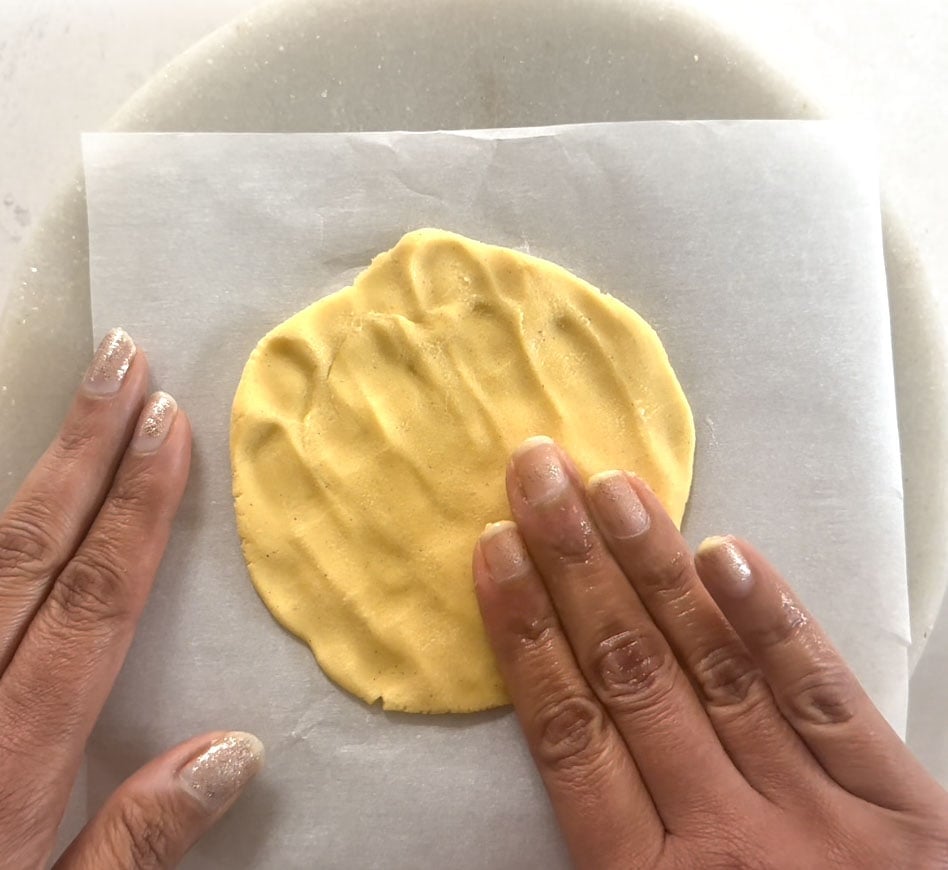
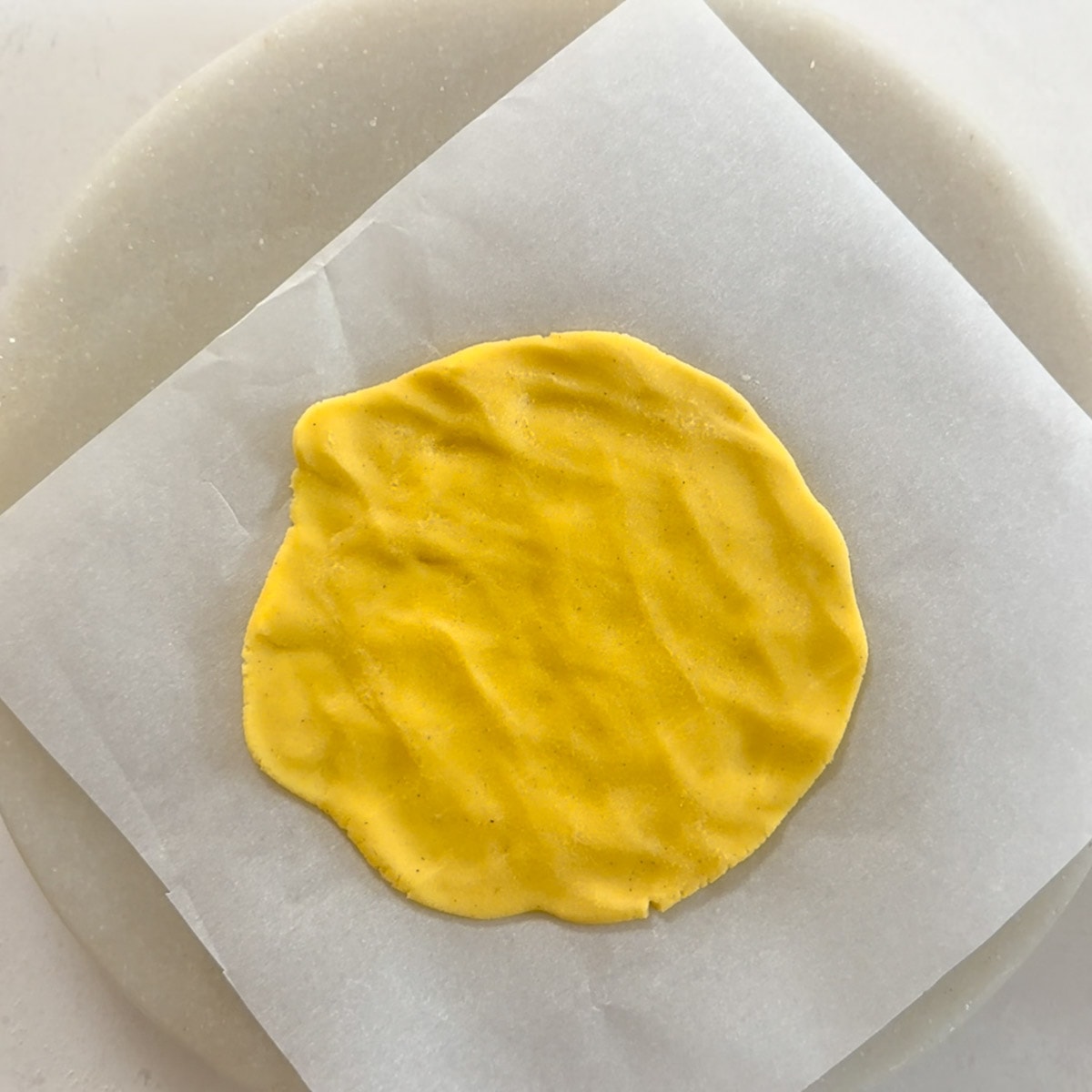
Roast Makki di Roti
- Heat a Tawa (griddle) on medium-high heat while you are rolling the roti. Carefully transfer the roti to the tawa. If you used a parchment paper, you can also transfer the roti with it and then peel off the parchment paper. You can also place the roti directly on the tawa and then peel off the parchment paper if that’s easier.
- Cook the roti on one side until it has brown spots, then flip and cook the other side. If you like, using tongs, transfer the roti to the open flame and roast on both sides to get the charred look.
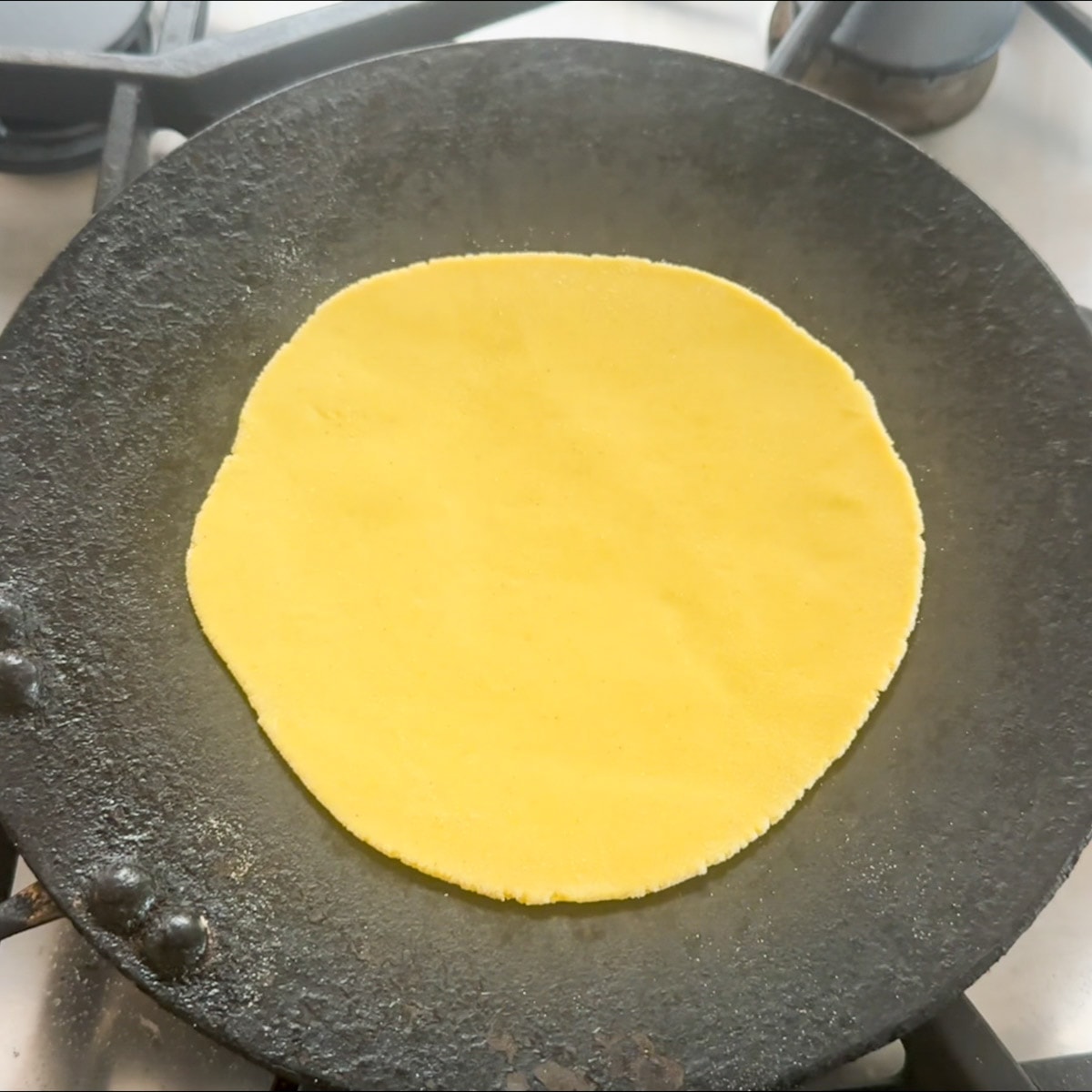
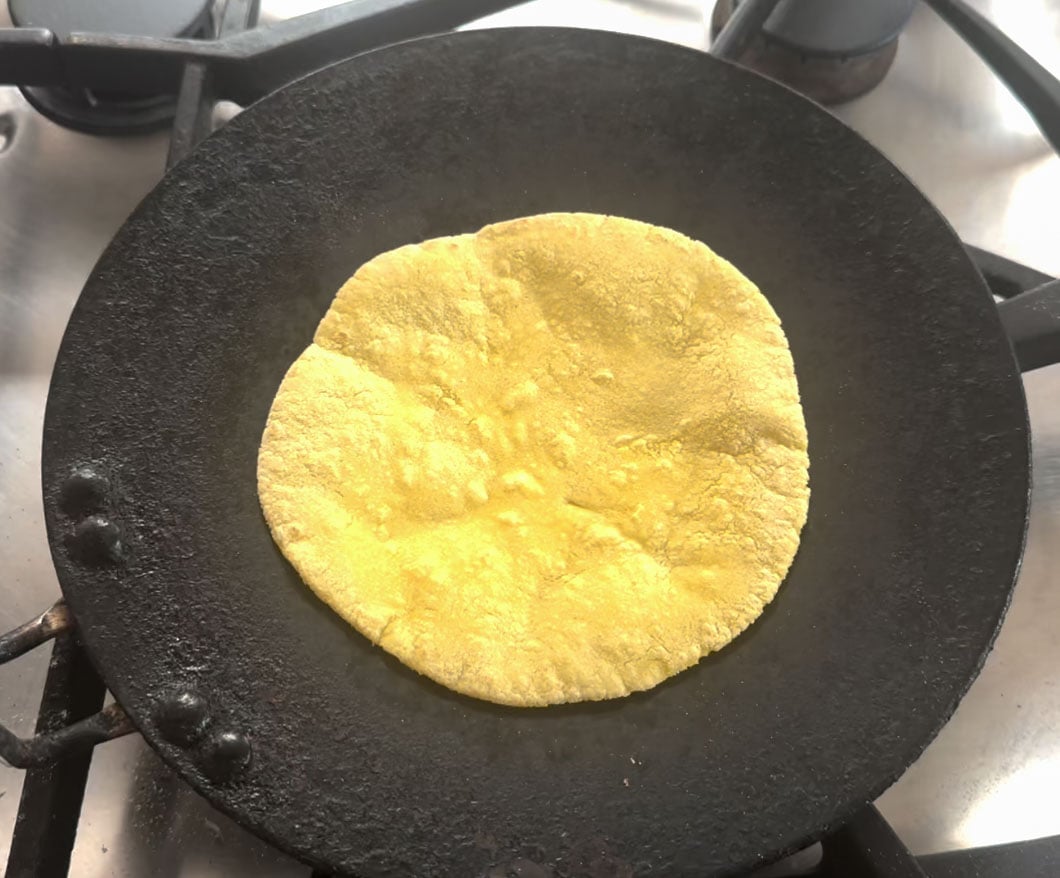
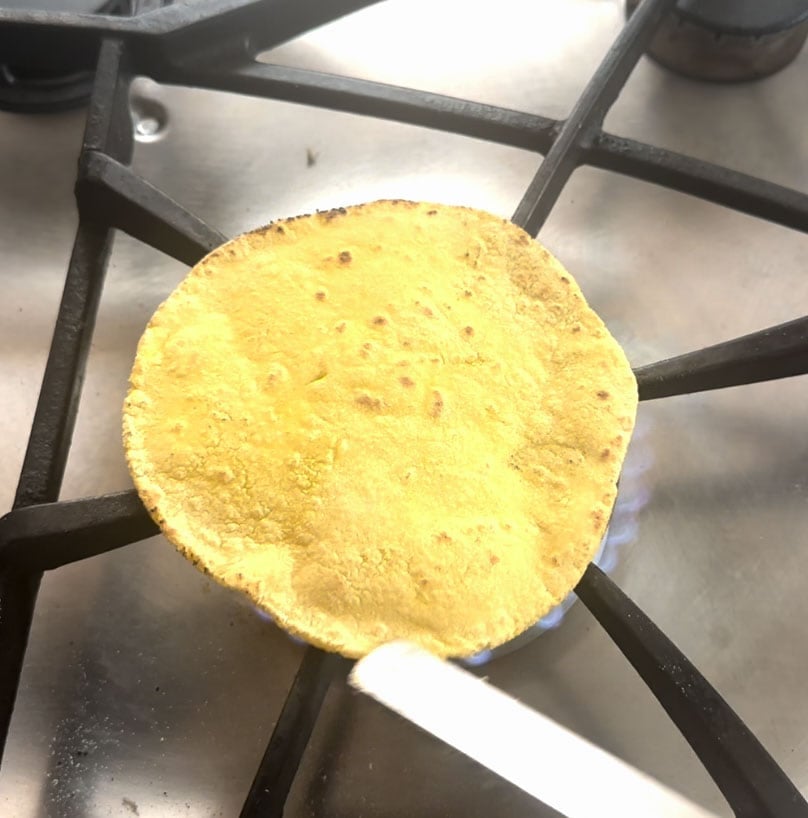
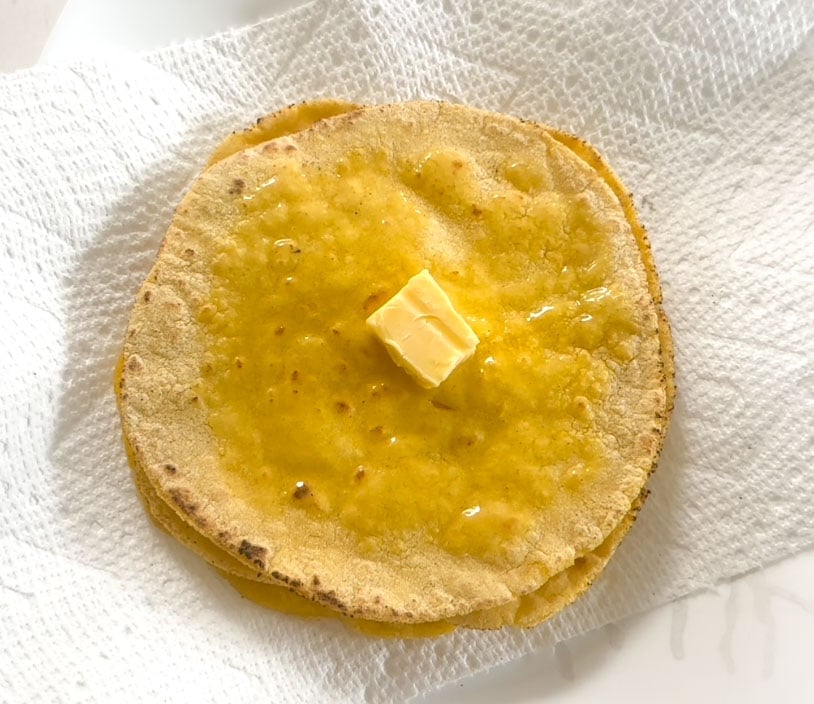
- Cook with ghee: Often, makki ki roti is cooked like a paratha (my mom cooks this way). Once there are brown spots on one side, flip and apply ghee/oil to the roti. Then flip again, and apply ghee to the other side. Roast till the roti is well cooked.
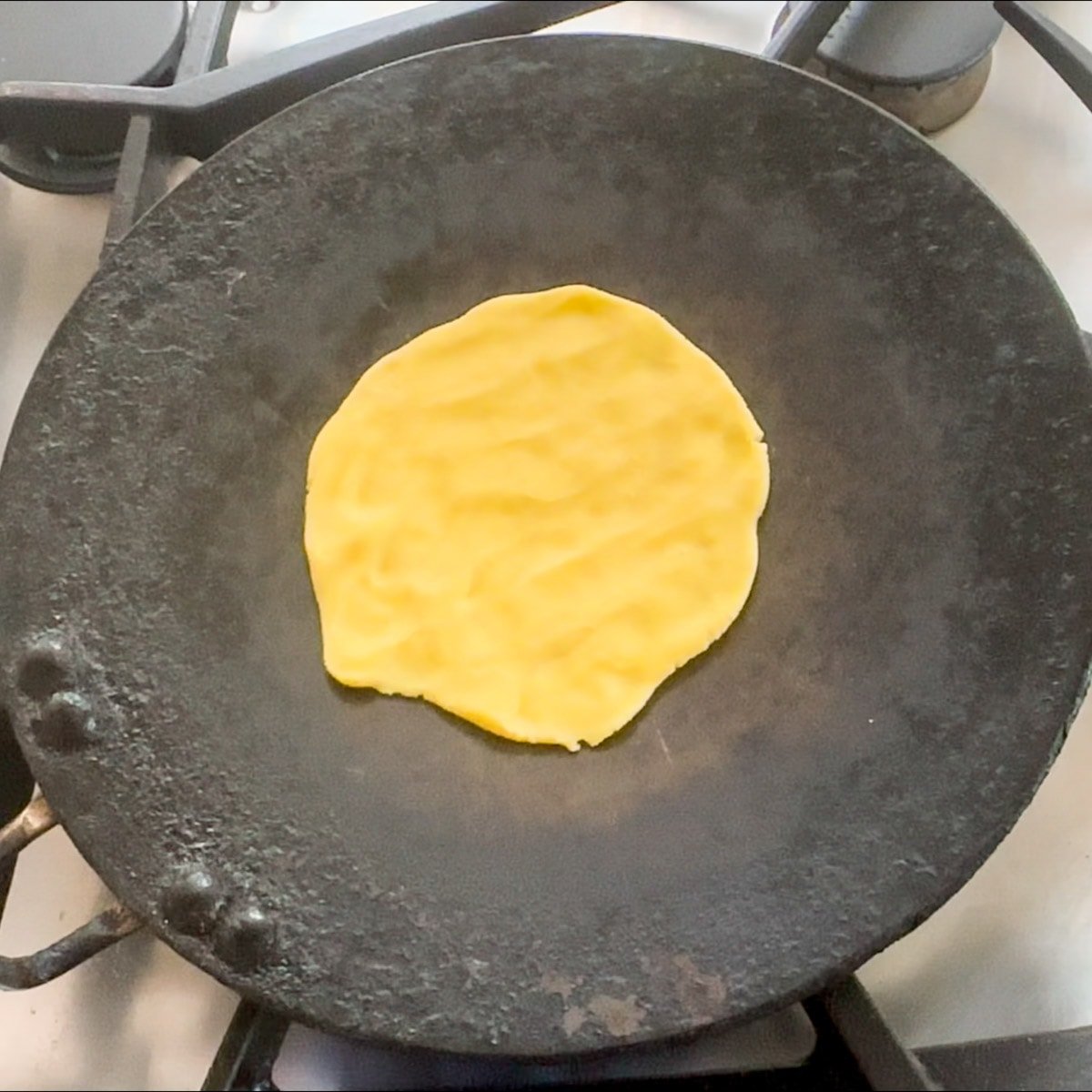
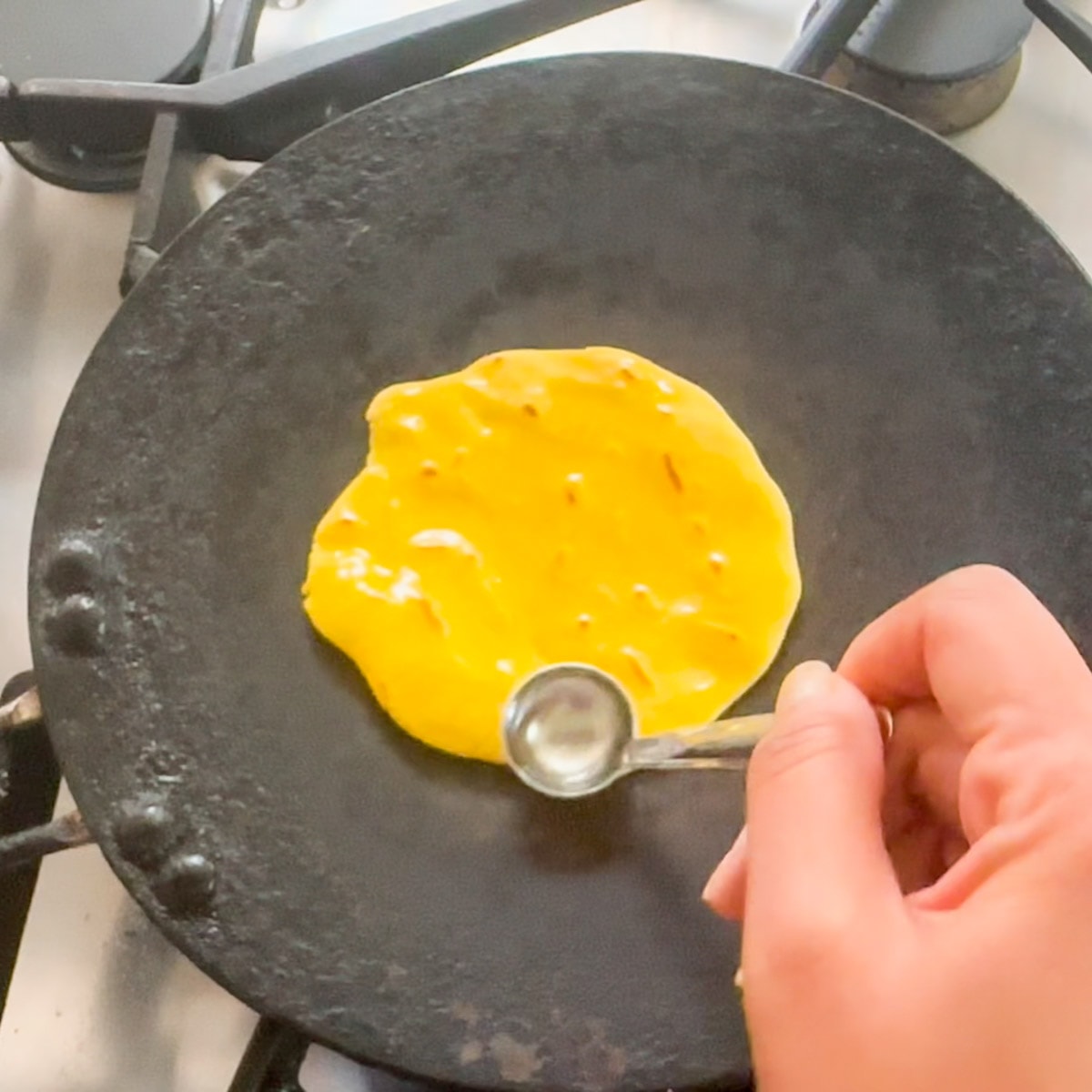
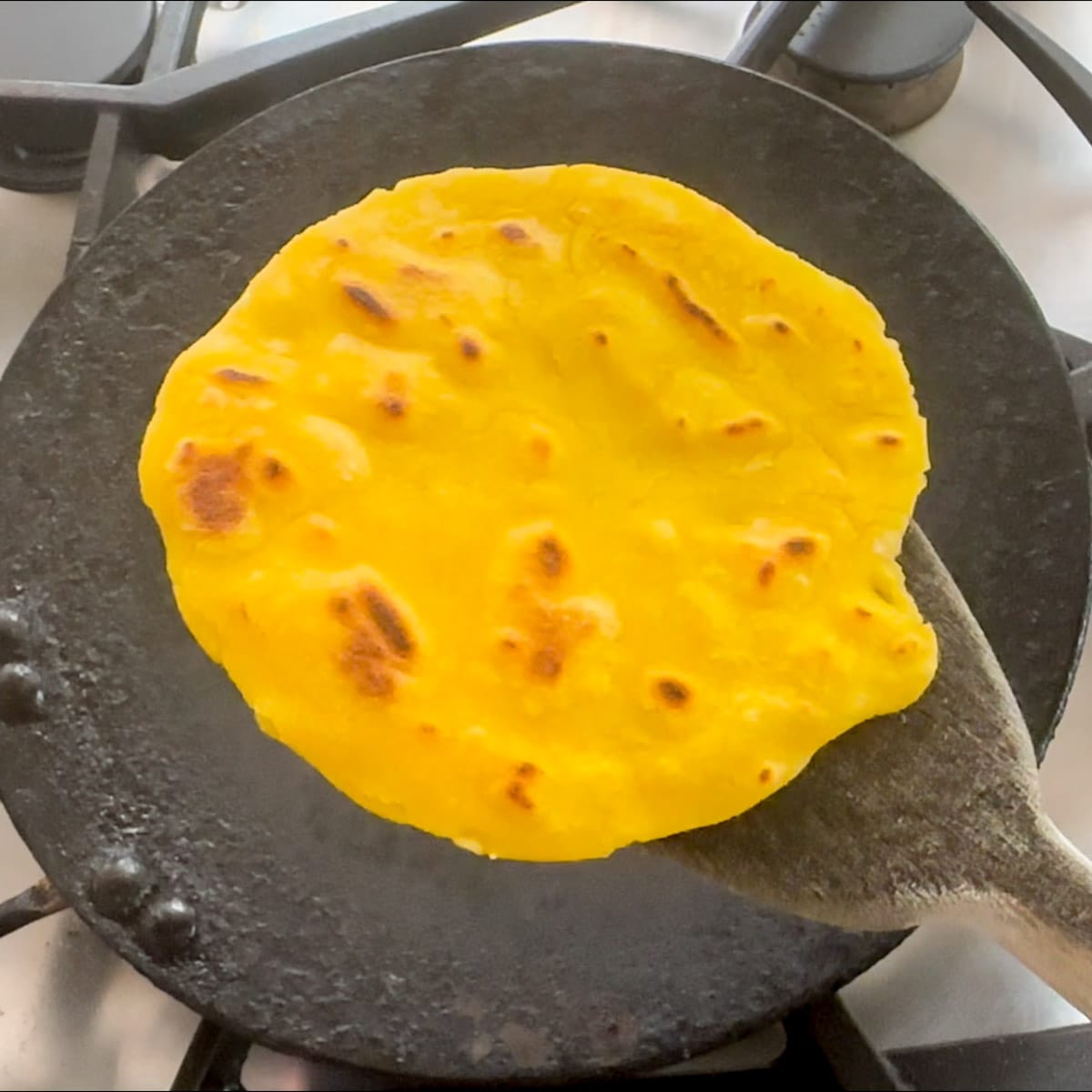
Transfer the makki ki roti to a plate and apply ghee or white butter. Similarly, cook the remaining rotis and serve them hot with sarson ka saag!
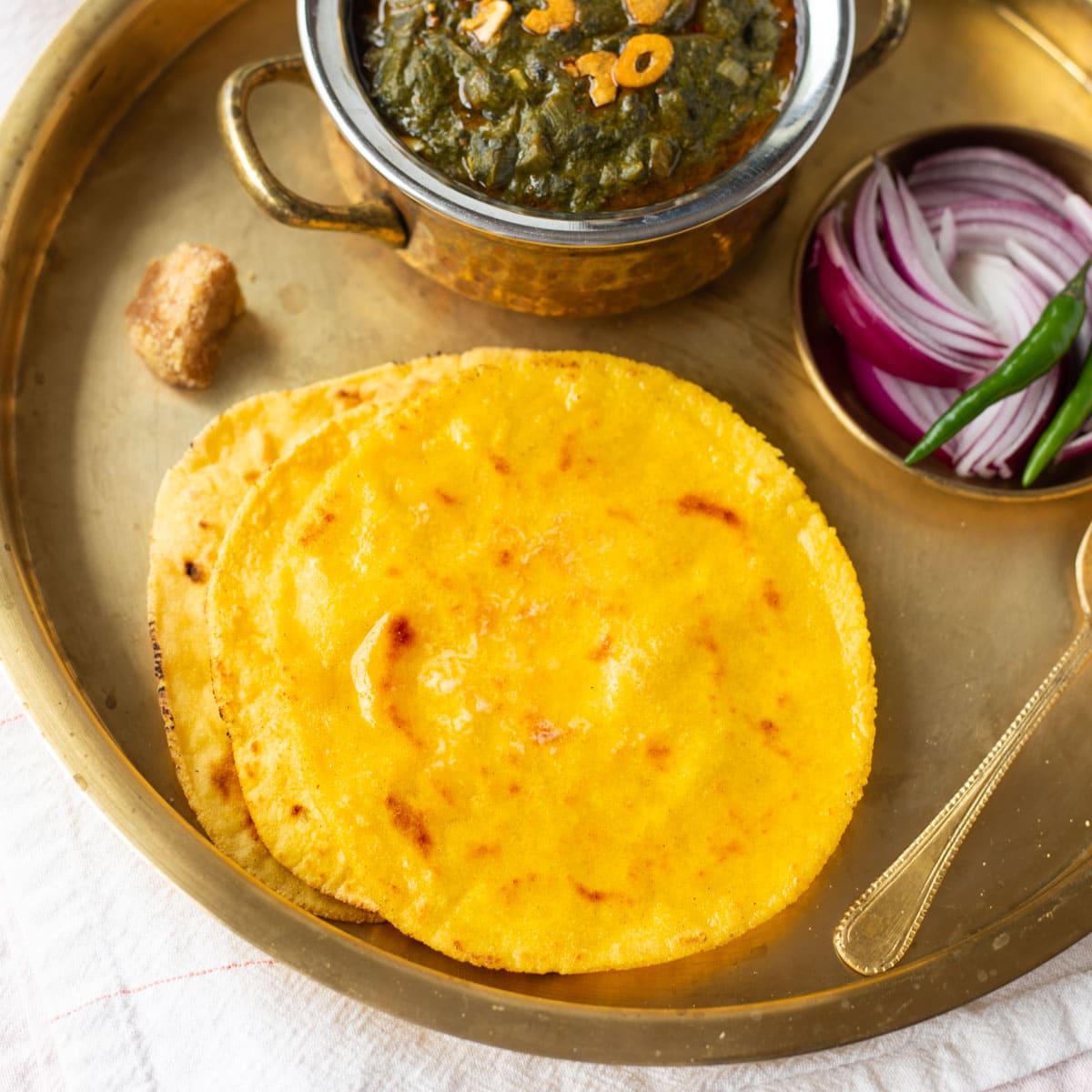
Pro-Tips for Perfect Makki ki Roti
Soft kneaded dough: Kneading soft and pliable dough is the most important part of making makki ki roti. Add more hot water as needed until you can make dough balls without any cracks. Cover the dough with a damp cloth at all times.
Knead dough balls: Just before rolling, you might need to knead the dough ball again, especially if it feels dry or has any cracks. Wet your hands with hot after and knead again, then form a ball.
Parchment paper: If you are having trouble rolling or transferring a rolled roti, then use parchment paper.
Thickness: Makki ki roti is thicker than whole wheat roti/chapati. So it is okay if you are not able to roll the thinnest rotis.
Roasting: These rotis take a little longer to cook as they are rolled thicker. Cook on an open flame to get the charred look. Or cook by smearing ghee on both sides, like a paratha.
Serve hot: These rotis are best served hot, right off the tawa. If you need to store them, then top them with ghee and cover them in a cloth or foil to keep them warm.
Variations
Grated Mooli/Radish: Some people add grated mooli when making the dough. This adds nourishment and can also make it easier to roll the rotis, as the grated radishes can form a mesh when rolling.
Whole Wheat flour: Add 1/2 cup of whole wheat flour if you are having trouble rolling with just the gluten-free flour.
Leafy Greens: You can also add leafy greens, such as radish leaves, fenugreek leaves, etc to make makki ke parathe. You can also add dried kasoori methi when making the dough.
What to Serve with Makki ki Roti?
Makki ki roti is best served hot, topped with a dollop of butter.
Most popularly, makki ki roti is paired with sarson ka saag, jaggery, onions, and pickle for an authentic Punjabi meal.
Some people enjoy leftover makki ki roti for breakfast with tea.
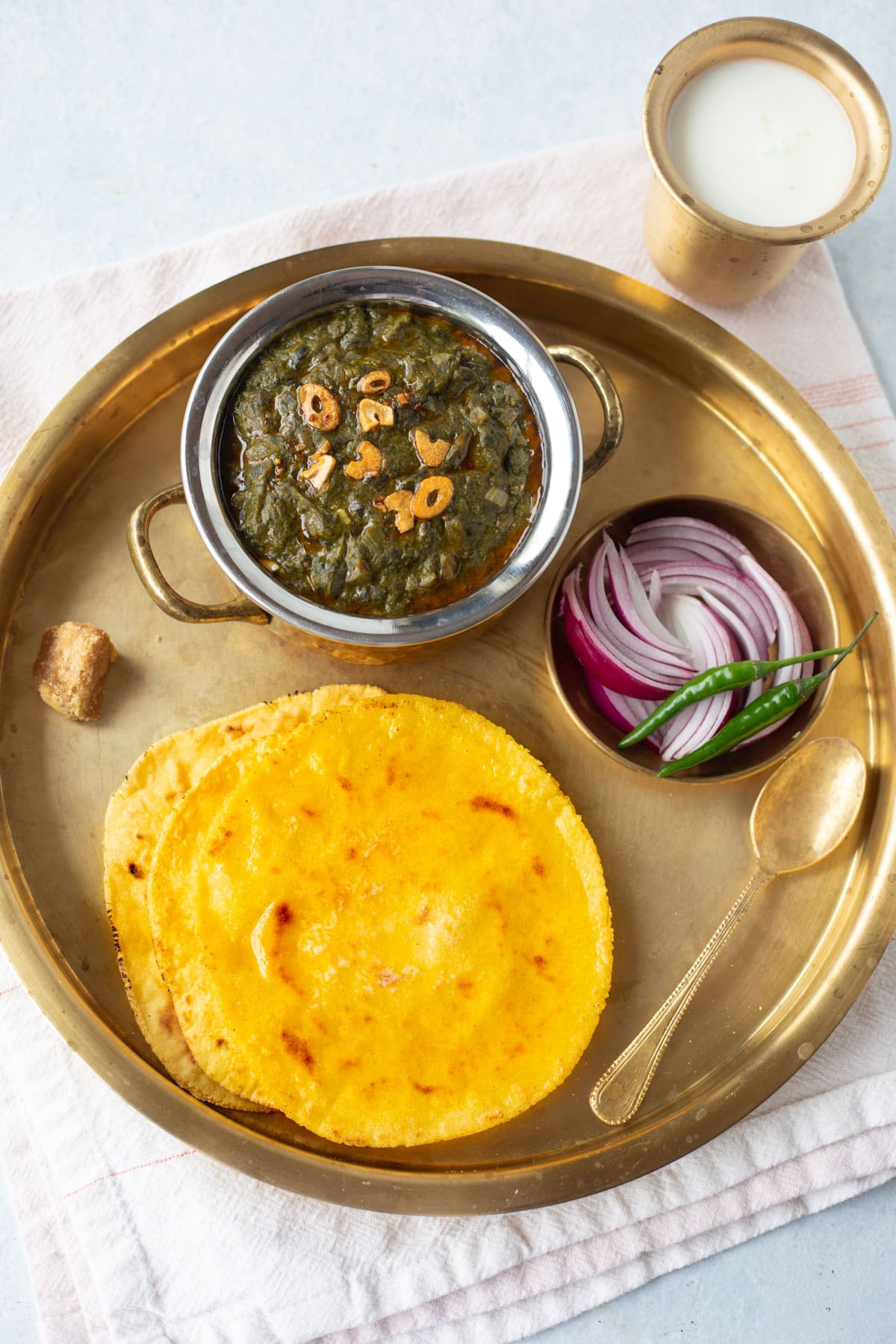
How to Store Makki ki Roti?
Makki ki roti is best served hot, but if you have leftovers, you can store them wrapped in a cloth or foil in a sealed container in the refrigerator for up to 2 days.
Reheat the roti on the tawa and apply ghee on both sides. As this is a gluten-free roti, it is soft and can break while reheating, especially if they were rolled thin.
Can I make Makki ki roti in advance?
I would highly recommend making and serving freshly cooked makki ki roti. However, you can store the prepared dough in the refrigerator for up to 2 days. Wrap the dough in a cling film or a wet cloth and store it in an airtight container.
Makki ki roti is breaking when I roll them?
If you are new to making makki ki roti, it can be hard to roll them, as the dough does not have any gluten. Make sure the dough is soft and pliable. Use parchment paper on the bottom and top when rolling. You can apply some oil on the parchment paper if you like. Use light hands if using a rolling pin to roll the dough.
You can make smaller size roti, and also it is okay for makki ki roti to be thicker, similar to a paratha. Finally, if the above does not help, and you can eat gluten, then add some whole wheat flour to the dough.
South Indian
How to make Dosa (Crispy Dosa Recipe)
Rice & Grains
Gujarati Methi Thepla (Easy, Authentic Recipe)
Breakfast
Paneer Paratha
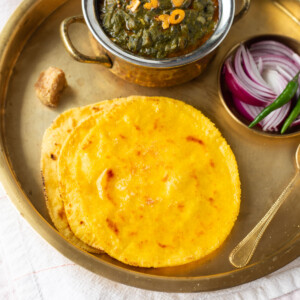
Makki ki Roti (Punjabi Cornmeal Flatbread)
Video
Ingredients
- 2 cup Makki ka Aata (Maize flour), + more for rolling, about 225 grams
- 1/2 teaspoon Carom seeds (Ajwain), optional
- 1/2 Salt
- 1 1/4-2 cup Water, add more as needed
- Ghee or Oil, for roasting, optional
- White Butter or Ghee , to spread on cooked roti (optional)
Instructions
Make Dough
- In a saucepan, add 1 1/4 cup of water and salt, and. Turn the flame to high and let it come to a boil.
- Turn off the flame and add the makki ka aata to the water. Mix the flour and water with a spatula. It will have a crumbly texture but will start to come together. Cover with a lid and let it rest for 10 minutes.
- Open the lid and transfer the mixture to a large plate or bowl. Apply hot water to your hands, and start to knead the dough. Use the heel of your palms to knead it. Keep kneading for 6-8 minutes until the dough is completely smooth. If the dough seems dry, add 1-2 tablespoons of warm water and knead again. The dough will be very soft by this time, and you should be able to form a ball without any cracks. Cover the dough with a wet cloth. Note: Depending on the quality and age of the flour, the total amount of water needed to make the dough can vary.
Roll Roti
- Take a small portion of the dough to form a ball. We want to work with one ball at a time. Knead the dough ball one more time until it is smooth. Apply hot water to your hands. If the dough ball seems dry, knead and make a ball again between your palms.
- Easy method: Apply some dry maize flour to the rolling board. Roll the ball in the maize flour and place it on the rolling board. Using a rolling pin, roll the roti with light hands into a 6-7 inch circle. You can also place the ball on a parchment paper to roll. This helps to make picking the rolled roti easier for the next step.
- Traditional method: Wet your hands with hot water. Take the dough ball in your hands and roll the dough between your hands in a circular motion to make a flat circle about double the size of the dough ball. Transfer this onto a parchment paper. Wet your fingers again and start patting the dough while moving the paper to roll evenly on all sides and making a circle. Don't roll too thin, as usually makki ki roti is thicker than wheat roti. If you are new to trying this method, you can make smaller 4-5 inch roti too.
Roasting Roti
- Heat a Tawa (griddle) on medium-high heat while rolling the roti. Carefully transfer the roti to the tawa. If you used a parchment paper, you can also transfer the roti with it and then peel off the parchment paper. You can also place the roti directly on the tawa and peel off the parchment paper if that's easier.
- Cook the roti on one side until it has brown spots, then flip and cook the other side. If you like, using tongs, transfer the roti to the open flame and roast on both sides to get the charred look.
- Cook with ghee: Makki ki roti is often cooked like a paratha (my mom cooks this way). Once there are brown spots on one side, flip and apply ghee/oil to the roti. Then flip again, and apply ghee to the other side. Roast till the roti is well cooked.
- Transfer the makki ki roti to a plate and apply ghee or white butter. Similarly, cook the remaining rotis and serve then hot with sarson ka saag!
